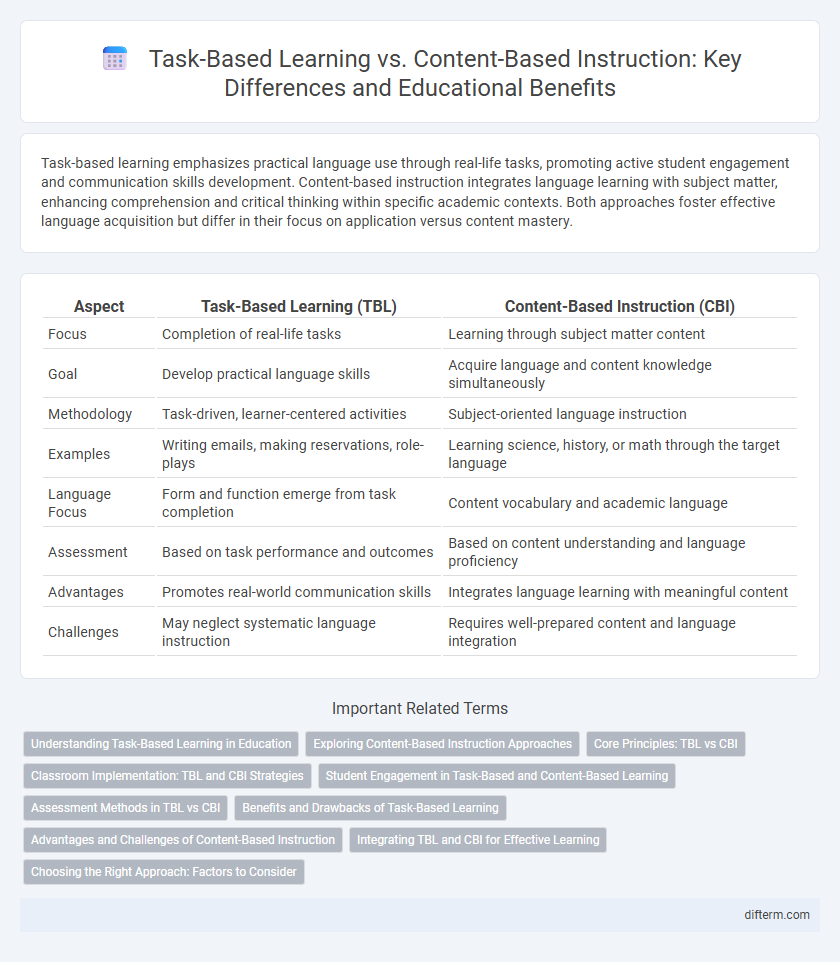Task-based learning emphasizes practical language use through real-life tasks, promoting active student engagement and communication skills development. Content-based instruction integrates language learning with subject matter, enhancing comprehension and critical thinking within specific academic contexts. Both approaches foster effective language acquisition but differ in their focus on application versus content mastery.
Table of Comparison
| Aspect | Task-Based Learning (TBL) | Content-Based Instruction (CBI) |
|---|---|---|
| Focus | Completion of real-life tasks | Learning through subject matter content |
| Goal | Develop practical language skills | Acquire language and content knowledge simultaneously |
| Methodology | Task-driven, learner-centered activities | Subject-oriented language instruction |
| Examples | Writing emails, making reservations, role-plays | Learning science, history, or math through the target language |
| Language Focus | Form and function emerge from task completion | Content vocabulary and academic language |
| Assessment | Based on task performance and outcomes | Based on content understanding and language proficiency |
| Advantages | Promotes real-world communication skills | Integrates language learning with meaningful content |
| Challenges | May neglect systematic language instruction | Requires well-prepared content and language integration |
Understanding Task-Based Learning in Education
Task-based learning in education centers on acquiring language and skills through meaningful tasks that mirror real-life activities, promoting active student engagement and practical application. This approach contrasts with content-based instruction, which prioritizes subject matter knowledge and language learning simultaneously, often through thematic units. Emphasizing completion of communicative tasks enhances critical thinking, problem-solving, and collaboration, making task-based learning highly effective for developing functional language proficiency.
Exploring Content-Based Instruction Approaches
Content-Based Instruction (CBI) integrates subject matter learning with language acquisition, emphasizing meaningful communication through academic content. This approach leverages thematic units and real-world materials to facilitate deeper understanding and language proficiency. Strategies such as sheltered instruction and the use of authentic texts enhance cognitive engagement and contextual learning in diverse educational settings.
Core Principles: TBL vs CBI
Task-based learning (TBL) emphasizes authentic language use through meaningful tasks that promote communication and problem-solving skills, prioritizing learner engagement and real-world relevance. Content-based instruction (CBI) integrates language learning with specific subject matter, focusing on acquiring knowledge and language simultaneously within disciplines like science or history. Both approaches value contextualized learning, but TBL centers on task completion while CBI revolves around mastering content through language acquisition.
Classroom Implementation: TBL and CBI Strategies
Task-based learning (TBL) in the classroom emphasizes real-life tasks that promote language use through meaningful interaction, such as problem-solving activities and role plays that prioritize communicative competence. Content-based instruction (CBI) integrates subject matter content with language learning, using materials like science texts or history lessons to enhance language acquisition within a specific academic context. Effective implementation of TBL involves designing authentic tasks that stimulate active student participation, while CBI requires alignment of curriculum content with language objectives to promote cognitive engagement and language development simultaneously.
Student Engagement in Task-Based and Content-Based Learning
Student engagement in task-based learning rises through active participation in practical, real-world tasks that promote authentic language use and critical thinking skills. Content-based instruction boosts engagement by integrating meaningful subject matter, fostering deeper comprehension and motivation via contextually relevant materials. Both approaches enhance cognitive involvement, but task-based learning often leads to higher interaction and collaboration among students.
Assessment Methods in TBL vs CBI
Task-based learning (TBL) assessment methods focus on evaluating students' ability to perform real-world tasks through authentic, performance-based tests that emphasize communication and problem-solving skills. In contrast, content-based instruction (CBI) assessments prioritize measuring students' understanding and retention of academic subject matter using traditional tests, quizzes, and content-specific evaluations. TBL assessments often involve rubrics and peer reviews tailored to task execution, while CBI relies more heavily on standardized testing formats aligned with curricular content.
Benefits and Drawbacks of Task-Based Learning
Task-based learning (TBL) enhances language acquisition by promoting real-life communication and problem-solving skills, fostering learner autonomy and motivation. It may present challenges such as requiring more teacher preparation, varying learner proficiency levels impacting task success, and less focus on explicit grammar instruction compared to content-based instruction (CBI). Despite these drawbacks, TBL effectively develops practical language use, making it a valuable approach in communicative language teaching.
Advantages and Challenges of Content-Based Instruction
Content-Based Instruction (CBI) enhances language acquisition by integrating subject matter learning with language development, promoting deeper cognitive engagement and real-world application. This approach facilitates improved vocabulary retention and critical thinking skills by contextualizing language within academic content, yet it demands substantial teacher expertise in both language pedagogy and subject knowledge. Challenges include the need for carefully designed materials to balance content and language goals, potential learner frustration with complex topics, and difficulties in assessing progress across dual objectives.
Integrating TBL and CBI for Effective Learning
Integrating Task-Based Learning (TBL) and Content-Based Instruction (CBI) enhances language acquisition by combining practical communication tasks with meaningful content engagement, promoting both fluency and comprehension. This blended approach leverages authentic materials and real-world tasks, enabling learners to develop critical thinking and subject-specific knowledge simultaneously. Research shows that students exposed to integrated TBL and CBI environments demonstrate improved motivation, retention, and language performance across diverse academic contexts.
Choosing the Right Approach: Factors to Consider
Selecting the appropriate approach between task-based learning and content-based instruction depends on learner goals, proficiency levels, and instructional contexts. Task-based learning emphasizes practical language use through real-world tasks, ideal for communicative competence development, while content-based instruction integrates language and subject matter learning, suitable for academic and thematic understanding. Consider factors such as learner motivation, curriculum goals, assessment methods, and resource availability to match the approach with educational objectives effectively.
Task-based learning vs Content-based instruction Infographic

 difterm.com
difterm.com